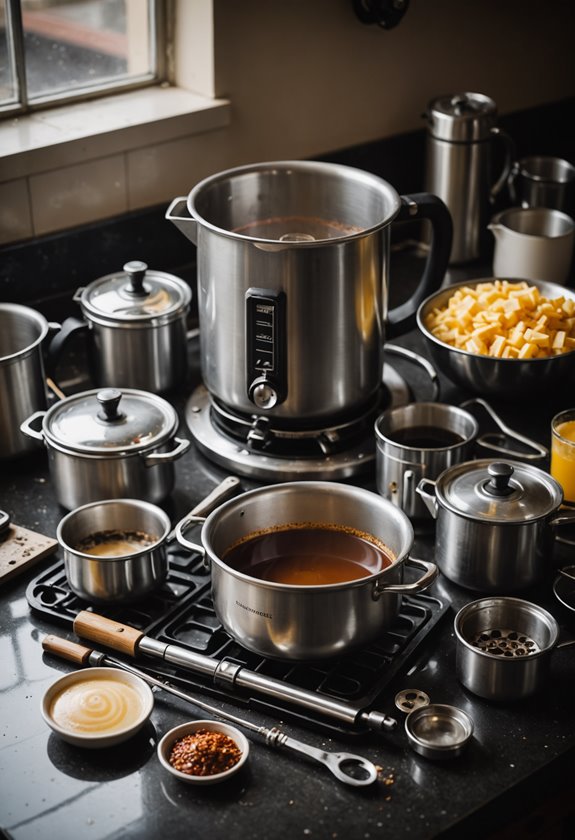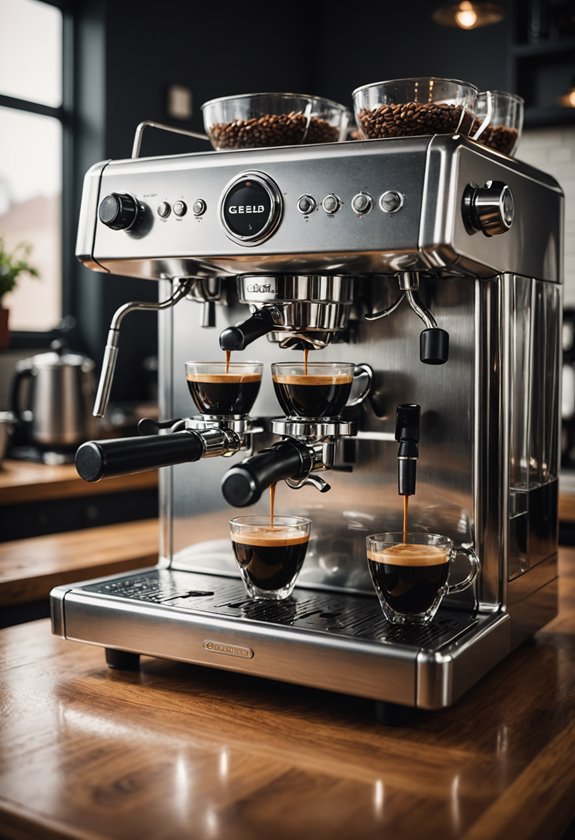How to Clean a Commercial Coffee Machine
You’ll need to clean your commercial coffee machine regularly to maintain peak performance and drink quality. Start with daily tasks like purging steam wands, wiping surfaces, and emptying drip trays. Weekly, deep clean your brew group using specialized cleaning powder and soak removable parts in warm, soapy water. The steam wand requires daily sanitizing with a damp cloth and periodic deep cleaning to prevent milk buildup. Every 1-3 months, descale your machine using a commercial descaler or a vinegar solution based on your water hardness. Following these essential steps will keep your machine running efficiently, and there’s plenty more to investigate about proper maintenance techniques.
Key Takeaways
- Perform daily cleaning of group heads using a blind filter and cleaning solution, followed by purging steam wands after use.
- Soak portafilters and brew components in Cafiza powder solution to effectively remove coffee oils and residue.
- Descale the machine every 1-3 months using commercial descaler or vinegar solution, based on local water hardness.
- Clean steam wands daily with sanitized cloth and specialized brush, ensuring proper milk system maintenance.
- Deep clean removable parts weekly in warm soapy water and inspect water reservoirs for mineral buildup.
Descaling Your Coffee Machine
While regular cleaning keeps your commercial coffee machine running smoothly, descaling is essential to remove mineral deposits that accumulate over time. Experts recommend descaling every 1-3 months based on water hardness in your area. Regular maintenance helps maintain optimal heating and ensures consistent brewing temperatures.
Using an eco-friendly descaler can help reduce your environmental impact while maintaining machine performance.
Before you begin the descaling process, you’ll need to turn off and unplug your machine, empty the water reservoir, and remove all detachable parts like the portafilter and drip tray.
Start by preparing your descaling solution, which can be either a commercial descaler designed for coffee machines or a mixture of equal parts water and vinegar.
Fill the reservoir with your chosen solution, then run the machine as if you’re brewing coffee to allow the solution to circulate through the internal components. Let it sit for about 15 minutes to break down stubborn limescale deposits.
Once you’ve completed the descaling cycle, it’s time to rinse thoroughly.
Empty the reservoir, fill it with fresh water and run multiple cycles until all traces of the descaling solution are gone.
Don’t forget to clean the steam wand and removable parts before reassembling.
For best results, maintain detailed records of your descaling schedule and consider using filtered water to reduce future mineral buildup.
Exterior Care and Maintenance
Maintaining your commercial coffee machine’s exterior appearance is just as vital as its internal cleaning. A well-kept exterior not only looks professional but also helps prevent the buildup of coffee residue, oils, and fingerprints that can damage your machine’s surfaces over time. Regular cleaning promotes optimal performance and efficiency of your equipment. This routine maintenance also helps preserve your machine’s Arabica bean flavors when brewing premium coffees like Illy.
Daily Cleaning Steps
You’ll want to create a simple cleaning solution by mixing two parts of warm water with one part of white vinegar in a spray bottle. After spraying this mixture on your machine’s exterior, let it sit briefly before wiping it down with a damp microfiber cloth, focusing on areas prone to coffee splashes and fingerprints. Always remember to shut down and unplug your machine before beginning any cleaning procedures.
Weekly Deep Cleaning
Once a week, perform a more thorough cleaning using baking soda and a non-abrasive pad to tackle stubborn grime. Pay special attention to the steam wand, control panel, and areas around the group heads. After scrubbing, wipe down all surfaces with a damp microfiber cloth, then dry thoroughly with a clean, dry cloth to prevent water spots.
Tools and Materials
Keep dedicated cleaning cloths, soft-bristle brushes, and non-abrasive sponges on hand for different cleaning tasks. This prevents cross-contamination and guarantees you’re using the right tool for each surface.
Cleaning The Brew Group

Three essential components make up the brew group: the portafilter, group heads, and dispersion plates. You’ll need to clean these parts regularly using Cafiza powder, which effectively removes coffee oils and residue. Hot water circulation helps maintain optimal temperature during cleaning.
Start by placing a blind filter into your portafilter and adding the measured cleaning powder, then lock it into place for backwashing. Similar to stainless steel grinders, proper maintenance ensures long-lasting performance and durability.
For thorough cleaning, you’ll want to use specific brushes for different surfaces. Use a nylon brush for regular cleaning, a brass brush for the brass dispersion plate, and a steel brush for the group screen.
Don’t forget to soak stubborn areas in hot water with Cafiza to loosen particles before scrubbing.
- Your espresso’s taste will dramatically improve with a clean brew group
- You’ll protect your investment by preventing costly repairs
- Your customers will notice the difference in quality and consistency
- You’ll feel confident knowing you’re serving the best achievable coffee
Remember to cycle the water flow on and off during backwashing, repeating about five times for ideal results.
For superautomatic machines like Philips or Saeco, remove the brew group completely for thorough cleaning and air drying.
Steam Wand Maintenance
Steam wands require careful daily attention to prevent milk buildup and guarantee peak performance. You’ll need to purge the wand before and after each use, while immediately wiping it down with a damp, sanitized cloth to remove milk residue.
For daily maintenance, you’ll want to use a cleaning brush on removable tips to clear any buildup inside. Don’t use sharp objects or harsh chemicals, as these can damage the wand’s delicate components. Instead, soak detachable parts in warm water with milk detergent regularly.
When performing deep cleaning, create a solution of warm water mixed with either Urnex Cafiza or white vinegar. Submerge the wand in this solution, run steam through it, and scrub away stubborn residue with a brush.
After cleaning, purge with clean water to remove any remaining solution. To prevent clogs, wrap a damp cloth around the wand and run steam through it to soften scalded milk. If you notice blocked steam holes, use a paper clip to gently clear them.
Remember to inspect your steam wand regularly and maintain a consistent cleaning schedule to ascertain proper function and longevity.
Similar to how a conical burr grinder maintains consistency in coffee grounds, regular steam wand maintenance ensures uniform steam pressure and temperature.
Caring for Removable Parts

To guarantee the ideal performance of your commercial coffee machine, proper care of removable parts is essential. Start by detaching all removable components, including the coffee pot, filter basket, and water reservoir, then soak them thoroughly in warm, soapy water to loosen any buildup or residue.
For daily maintenance, you’ll want to hand-wash these parts with dish soap after each use, or if they’re dishwasher-safe, run them through a cleaning cycle.
Don’t forget to leave the reservoir lid open to guarantee complete drying, which prevents bacterial growth and maintains peak functionality.
- Your customers deserve coffee that’s free from yesterday’s grounds and buildup
- Your investment in quality equipment demands proper maintenance
- Your reputation depends on consistently great-tasting beverages
- Your staff’s efficiency relies on well-maintained equipment
When it’s time to reassemble your machine, verify each component is completely dry and properly secured.
Pay special attention to the brew group and follow manufacturer guidelines for proper placement.
Remember to use a soft brush for reusable filters and a microfiber cloth for stubborn buildup, as harsh scrubbing can damage delicate parts.
Essential Maintenance Tips
Maintaining your commercial coffee machine requires a combination of daily, weekly, and monthly tasks to guarantee peak performance and longevity.
Let’s investigate the essential routines you’ll need to follow.
For daily maintenance, you’ll want to clean your group heads using a blind filter and cleaning solution, while also emptying and sanitizing drip trays with warm, soapy water.
Don’t forget to purge steam wands after each use and wipe down external surfaces to prevent buildup.
Weekly tasks should include a deep clean of your group heads by soaking portafilters and scrubbing with a specialized brush.
You’ll need to descale the machine using a mild acidic solution and inspect milk systems for any residue accumulation.
For long-term care, make sure you’re testing water quality regularly and using filtered water to prevent limescale buildup.
Replace water filters annually, and schedule professional inspections every six months to evaluate steam pressure and internal components.
Keep track of your grinder burrs, replacing them every 6 to 18 months depending on your usage volume, and inspect gaskets regularly for signs of wear.
Using universal descaler tablets can effectively remove mineral deposits without damaging your machine’s components.
Frequently Asked Questions
How Often Should I Replace the Gaskets in My Commercial Coffee Machine?
You’ll need to replace your commercial coffee machine’s gaskets every 3-6 months, depending on usage. In high-volume settings like cafes, replace them more frequently to maintain proper seals and pressure.
What Signs Indicate That My Coffee Machine’s Pump Needs Maintenance?
You’ll notice your pump needs maintenance when it runs irregularly, makes unusual sounds, produces weak water flow, shows pressure fluctuations, or fails to maintain consistent brewing pressure during extraction.
Can I Use Bleach-Based Cleaners on My Commercial Coffee Machine?
You shouldn’t use bleach-based cleaners in your coffee machine. They’re hazardous to health, can corrode machine parts, leave harmful residues, and won’t effectively remove mineral deposits. Use vinegar or citric acid instead.
How Do I Know When the Heating Element Needs Replacement?
You’ll need to replace your heating element when water heats slowly, temperatures fluctuate during brewing, steam production weakens, or you notice strange smells and unusual noises during operation.
Should I Lubricate Any Parts of My Commercial Coffee Machine?
You’ll need to regularly lubricate your machine’s brew unit, valves, grinders, and seals using food-grade lubricants. Follow manufacturer guidelines and get professional maintenance to guarantee proper lubrication and performance.







